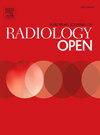Weight-bearing MRI of the cervical spine: A scoping review of clinical utility and emerging applications
IF 2.9
Q3 RADIOLOGY, NUCLEAR MEDICINE & MEDICAL IMAGING
引用次数: 0
Abstract
Objective
Weight-bearing magnetic resonance imaging enables assessment of the cervical spine and craniocervical junction under physiological load, potentially revealing pathology that is occult on conventional supine imaging. This scoping review synthesizes current evidence, maps clinical and emerging applications, and identifies key gaps requiring further investigation.
Methods
A structured search was conducted in PubMed, Scopus, Web of Science, Google Scholar, and Semantic Scholar (July 2025). Eligible studies were reviewed for diagnostic utility, technical considerations, clinical indications, and outcomes. Methodological quality was appraised descriptively in line with Joanna Briggs Institute guidance.
Results
Nine studies, published between 2008 and 2025, met inclusion criteria. Upright and dynamic MRI detected posture-dependent changes including spinal canal narrowing, cord compression, foraminal stenosis, ligamentous buckling, cerebellar tonsillar descent, altered sagittal alignment, and CSF flow differences. Findings were more pronounced in flexion extension and upright postures compared with supine imaging. Normative studies established reference metrics for CCJ motion and prevertebral soft tissue width. Preliminary evidence also highlights applications in connective tissue disorders, Chiari malformation, and upper cervical chiropractic practice, although most studies were feasibility reports with small sample sizes and heterogeneous protocols.
Conclusion
Emerging evidence suggests that WBMRI provides added diagnostic value in selected cervical spine and CCJ conditions by revealing dynamic or load-sensitive pathology not captured on standard supine imaging. While current evidence remains preliminary, standardized protocols, higher-field technologies, and large multicenter outcome-based studies are essential to validate diagnostic thresholds, improve reproducibility, and define the role of WBMRI in routine clinical care.
颈椎负重MRI:临床应用和新兴应用的范围综述
目的负重磁共振成像能够评估生理负荷下的颈椎和颅颈交界处,潜在地揭示传统仰卧位成像所隐藏的病理。这一范围审查综合了目前的证据,绘制了临床和新兴应用地图,并确定了需要进一步调查的关键差距。方法在PubMed、Scopus、Web of Science、b谷歌Scholar、Semantic Scholar(2025年7月)中进行结构化检索。对符合条件的研究进行了诊断效用、技术考虑、临床适应症和结果的审查。方法质量按照乔安娜布里格斯研究所的指导进行描述性评价。结果2008年至2025年间发表的9项研究符合纳入标准。直立和动态MRI检测到姿势依赖性变化,包括椎管狭窄、脊髓压迫、椎间孔狭窄、韧带屈曲、小脑扁桃体下降、矢状面排列改变和脑脊液流量差异。与仰卧位相比,屈伸位和直立位的影像学表现更为明显。规范研究建立了CCJ运动和椎前软组织宽度的参考指标。初步证据也强调了结缔组织疾病、Chiari畸形和上颈椎捏脊术的应用,尽管大多数研究都是小样本量和异质方案的可行性报告。结论:越来越多的证据表明,WBMRI通过揭示标准仰卧位成像未捕获的动态或负荷敏感病理,为选定的颈椎和CCJ疾病提供了额外的诊断价值。虽然目前的证据仍然是初步的,但标准化的方案、更高领域的技术和基于结果的大型多中心研究对于验证诊断阈值、提高可重复性和确定WBMRI在常规临床护理中的作用至关重要。
本文章由计算机程序翻译,如有差异,请以英文原文为准。
求助全文
约1分钟内获得全文
求助全文
来源期刊

European Journal of Radiology Open
Medicine-Radiology, Nuclear Medicine and Imaging
CiteScore
4.10
自引率
5.00%
发文量
55
审稿时长
51 days
 求助内容:
求助内容: 应助结果提醒方式:
应助结果提醒方式:


